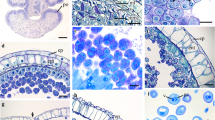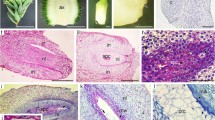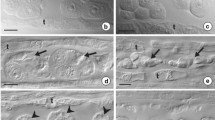Abstract
In Sedum fabaria, the ovule is anantropus, bitegmic and crassinucellate. The development of the nucellus conforms to the Sedum type. The development of the embryo sac is of the Allium type. The antipodal cells in unfertilized embryo sac occasionally divide and one of them forms four-celled structures resembling embryos and remaining once elongate in the form of haustoria. The entry of the pollen tube is porogamous. After division the primary endosperm nucleus forms two cells: the apical one develops into cellular endosperm according to the Acre type and the basal one acts as the endosperm haustorium of the Sempervivum type. The embryogeny corresponds to the Caryophyllad type.
Similar content being viewed by others
References
Battaglia, E.: Usual cytological features in the apomictic Rudbeckia sullivantii Boynton et Beadle.-Caryologia 8: 1–32, 1955.
Edahl, I.: Die Entwicklung von Embryosack und Embryo bei Ulmus glabra Huds.-Sven. Bot. Tidskr. 35: 143–156, 1941.
Fagerlind, F.: Die Samenbildung und die Zytologie bei angiospermischen und sexuellen Arten von Elatostema und einiger nahestehenden Gattung nebst Beleuchtung einiger damit zusammenhangender Probleme.-K. sven. Vetensk.-Akad. Handl. III 21: 1–130, 1944.
Gopinath, D.M.: Cases of antipodal polyembryony in Alangium lamarckii Thw.-Curr. Sci. 12: 329–330, 1943.
Guignard, J.L., Mestre, J.C.: Sur le développement d'embryons à partir des antipodes chez l'Ulmus campestris L.-Bull. Soc. Bot. France 113: 227–228, 1966.
Haberlandt, G.: Zur Embryologie und Cytologie von Allium odorum L.-Ber. deut. bot. Ges. 43: 559–564, 1925.
Hegelmaier, F. Zur Kenntnis der Polyembryonie von Allium odonum L.-Bot. Zeit. 55: 133–140, 1897.
Herr, J.M.: A new clearing-squash technique for the study of ovule development in angiosperms.-Amer. J. Bot. 58: 785–790, 1971.
Johansen, D.A.: Apomictic embryogeny.-In: Johanson, D.A. (ed.): Plant Embryology. Pp. 271–282. Chronica Botanica Company, Waltham 1950.
Johri, B.M., Ambegaokar, K.B.: Embryology: then and now.-In: Johri, B.M. (ed.): Embryology of Angiosperms. Pp. 1–52. Springer-Verlag, Berlin-Heidelberg 1984.
Johri, B.M., Ambegaokar, K.B., Srivastava, P.S.: Crassulaceae.-In: Johri, B.M., Ambegaokar, K.B., Srivastava, P.S. (ed.): Comparative Embryology of Angiosperms. Pp. 369–372. Springer-Verlag, Berlin-Heidelberg 1992.
Kojima, A., Nagato, Y.: Pseudogamus embryogenesis and the degree of parthenogenesis in Allium tuberosum.-Sex. Plant Reprod. 5: 79–85, 1992.
Mauritzon, J.: Studien über die Embryologie der Familien Crassulaceae und Saxifragaceae.-Thesis. University of Lund, Lund 1933.
Modilewski, J.: Zur Kenntnis der Polyembryonie von Allium odorum L.-Bull. Jard. Bot. Kief 7–8: 65–70, 1925.
Modilewski, J.: Neue Beitrage zur Polyembryonie von Allium odorum L.-Ber. deut. bot. Ges. 48: 285–295, 1930.
Narayanaswami, S.: The structure and development of the caryopsis in some Indian millets. III. Paspahon scrobiculatum L.-Bull. Torrey bot. Club 81: 288–299, 1954.
Pullaiah, T.: Studies in the embryology of Compositeae III. The tribe — Asteraceae.-Bot. Mag. (Tokyo) 91: 197–205, 1978.
Shattuck, C.H.: A morphological study of Ulmus americana.-Bot. Gaz. 40: 209–233, 1905.
Tretjakow, S.: Die Betheiligung der Antipoden in Fallen der Polyembryonie bei Allium odorum L.-Ber. deut. bot. Ges. 13: 13–17, 1895.
Yakovlev, M.S., Solntseva, M.P.: [Some problems of flower morphology and embryology of feather-grasses.]-In: Yakovlev, M.S. (ed.): Morfologiya Tsvctka i Reproduktyvnyï Protsess u Pokrytosemennykh Rasteniï. Pp. 61–73. Nauka, Moskva-Leningrad 1965. [In Russ.]
Young, B.A., Sherwood, R.T., Bashaw, E.C.: Cleard-pistil and thick-sectioning techniques for detecting aposporus apomixis in grasses.-Can. J. Bot. 57: 1668–1672, 1979.
Author information
Authors and Affiliations
Rights and permissions
About this article
Cite this article
Wojciechowicz, M., Samardakiewicz, M. The development of female gametophyte and antipodal embryo formation in Sedum fabaria. Biologia Plantarum 40, 193–202 (1997). https://doi.org/10.1023/A:1001008317890
Issue Date:
DOI: https://doi.org/10.1023/A:1001008317890




